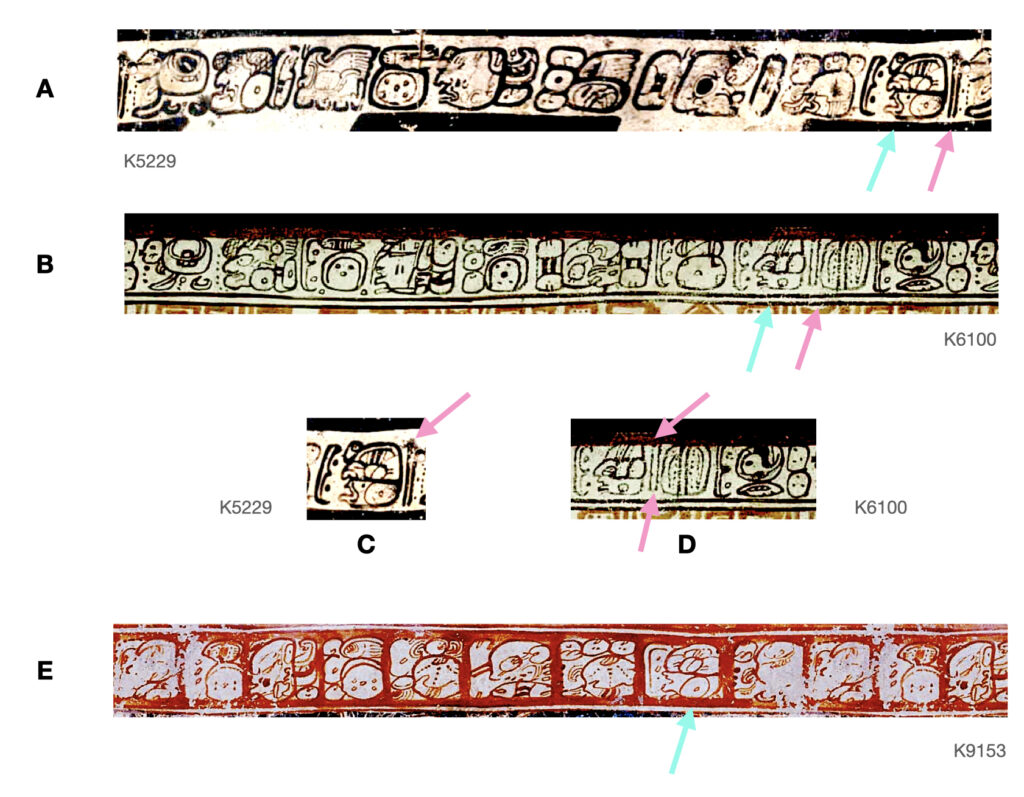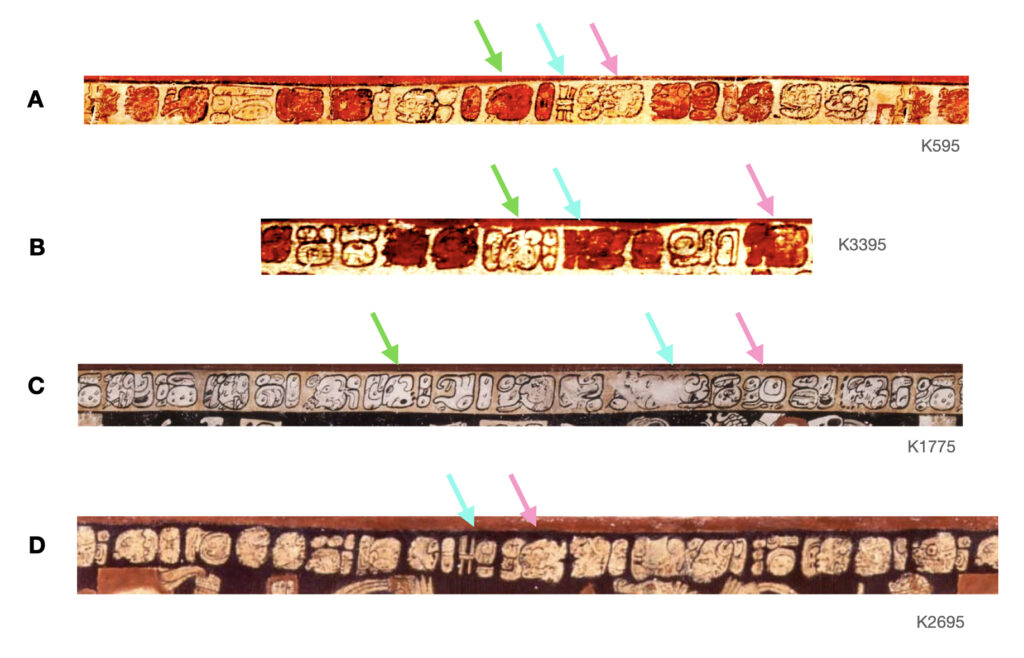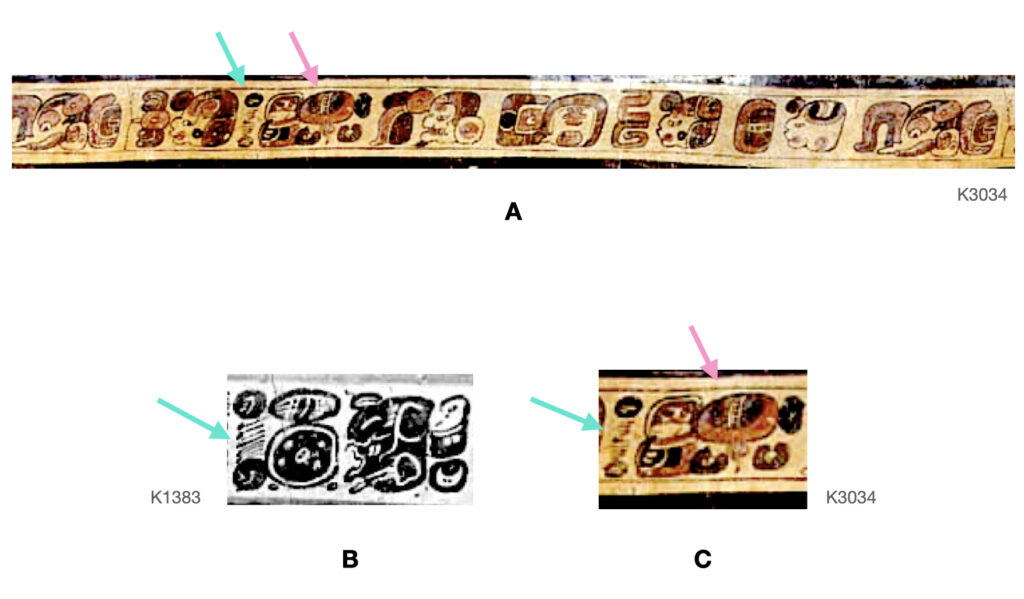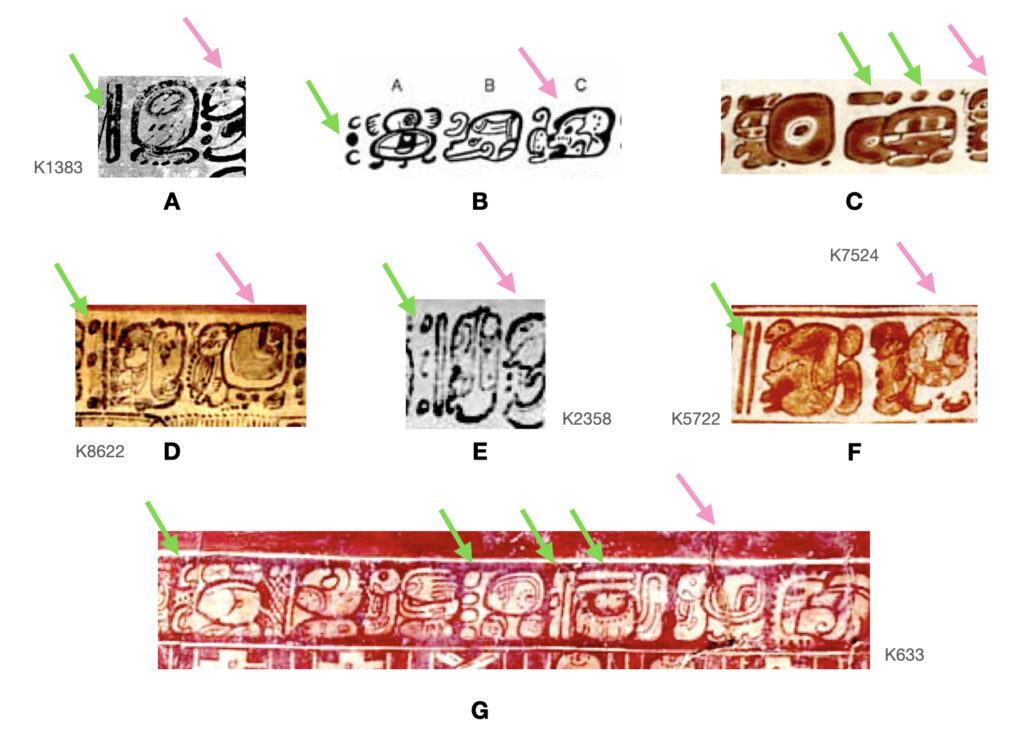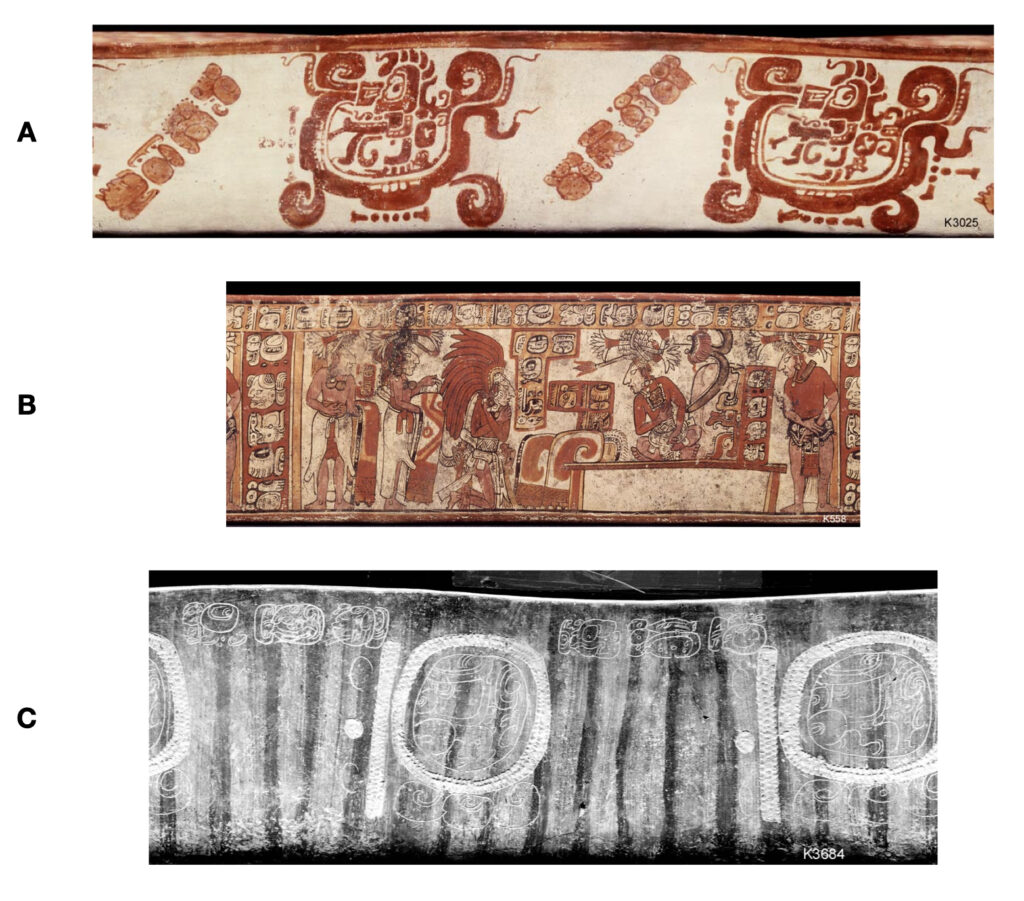An Evaluation of the Recent Proposal of Punctuation Marks on Mayan Ceramic Texts
David F. Mora-Marín
davidmm@unc.edu
University of North Carolina
Chapel Hill
10/13/2022
In a recent publication, Grube (2021) has proposed that certain signs, some of them previously suggested by Coe and Kerr (1998) to constitute cases of “space fillers,” actually functioned as punctuation marks. Although this is a very stimulating proposal, there is an alternative explanation, in addition to the space-filler function. The alternative explanation that I favor here could have become the basis, through analogical reanalysis, for the punctuation function advanced by Grube, should such function be validated. This alternative is simple: many cases of so-called space fillers or punctuation marks are actually examples of signs present in the glyphic collocations that would have followed should there have been more room to continue the text. This is of course not a novel idea: epigraphers have known of such occurrences for a long time (e.g. Mora-Marín 2001:128, 2004:11), and Grube (2021) himself provides a few examples, as I review below. What I propose is that most, if not all, examples of text-ending signs that appear “unnecessary” may in fact be cases of signs that would have begun collocations for which there was no space available, and were therefore leftovers or remnants of the following collocation in the sequence. The way this “leftover” function and the punctuation function may be related is also simple: over time, scribes may have reanalyzed some leftover signs, if especially common or visually salient, as text-ending markers, given that they would, by definition, appear at the —unavoidable— end of a text. Let us review some of the evidence.
First, we begin with Coe and Kerr (1998:143), who state that: “From time to time one does see the effect of compression near the end of lengthy Primary Standard Sequence [PSS] texts, or the use of space fillers where the line of glyphs does not quite ‘make it to the end’, but in general cases like this are rare.” Those authors presented an example in which the PSS text ends in the syllabogram yu, specifically the case of K1355, seen in Figure 1A. Though Coe and Kerr (1998) proposed a space-filler function for such sign, a different analysis is preferable. This example bears a text consisting of the Initial Sign Collocation followed by the verbal expression tz’i-b’i na-ja ji-chi for tz’ihb’naj-Ø-Ø-ich (writing-PASSIVE.DER.TV-3sABS-PLAIN.COMP.IV-already/indeed) ‘it was indeed painted’. The text ends in T62 yu (light blue arrows). One could argue that this is a text-ending punctuation mark or a space filler. But it is neither. It is the first sign of the common collocation yu-k’i-b’i for y-uk’-ib’ ‘his/her cup’, which typically serves as the subject of the verb. In fact, Figure 1B shows an example from K9291 that ends in yu-k’i and immediately precedes the Initial Sign Collocation that begins the text. Figure 1C shows an example from K5350 that also ends in yu-k’i. Both are examples of texts where the scribe ran out of space to include the b’i syllabogram that would typically conclude the collocation. Compare with Figure 1D, which shows an example from K4552 that ends in the complete collocation yu-k’i-b’i, and with Figure 1E, which show an example from K4551 the ends in the collocation yu-k’i-b’i and the syllabogram ta, which would precede either yu-ta-la ka-wa or ʔu-lu, yielding a phrase such as tä y-ut-al käkäw ‘for cacao seeds’ or tä ʔul ‘for atole’. This set of examples shows that “leftovers” —signs or partial sequences that provided an (accidentally) incomplete spelling of a collocation— were a common phenomenon, and that they were generally predictable. Thus, these incomplete expressions filled the space, but were not meant to be space fillers originally.
Figure 1
Next, we turn to Grube (2021:5), who argues that “these markings fulfill a real syntactic function rather than just expressing the fear of a horror vacui, because they are highly conventionalized and appear on ceramics from different periods and in different painting styles.” He proposes two types of such text-ending punctuation markers: 1) “one or two vertical lines indicating the end of a dedication formula” (Figure 2A); and 2) “two vertically arranged dots or circles, sometimes with small fillers added” (Figures 2B–D). In Figure 2 the blue arrows point to the proposed punctuation marks, the pink arrows to the Initial Sign Collocation that begins each text. Grube further asserts that “So far, these punctuation marks can only be shown to have existed within the context of dedication texts on ceramics” (2021:5).
Figure 2
Grube distinguishes these cases from instances where a text ends in a single, isolated syllabogram. For such examples, Grube (2021:4) proposes the presence of grammatical morphemes that would be consistent with a text-ending role:
Sometimes, scribes filled the open space with single syllabograms. On Kerr 595, the scribe inserted the che sign, perhaps hintng at the Cholan quotative che’ “he says” and thus confirming that the text was understood as an item of collective memory (Kaufman and Norman 1984: 139). On another vase (Kerr 7459), the scribe added the sign la, perhaps indicating the word laj “finish” or “completely, all” (Kaufman and Norman 1984:124), to mark the end of the Primary Standard Sequence.
Grube (2021:5) is also open to a different approach, one that sees the text-ending isolated signs as the beginning parts of known collocations, as already shown above:
In yet other examples, the scribe has simply written a sign of the following word to fill the gap, e.g. SAK to indicate the implied title sak wayis, or a single syllabic sign cha to indicate a following chatahn winik expression (Kerr 2723; 2773; 4988; 5064; 5391; 5646; 8651; 8823).
But Grube does not follow this approach for cases where the text-ending signs resemble lines or dots, which he instead analyzes as punctuation markers. Nevertheless, the same explanation offered above for the isolated yu syllabogram on K1355, or by Grube for cases such as the text-ending instances of SAK or cha, can also be posited for instances where lines or dots, actually, bar-and-dot numerals, appear to end the text. In fact, the same explanation can be offered in most instances of isolated syllabograms appearing in text-ending positions, including the che example noted by Grube.
I will start with one of Grube’s examples of signs resembling lines or dots, seen in Figure 3A, the textual band from K5229. The pink arrow shows the vertical “lines” that Grube proposes to be the text-ending punctuation marker. The light blue arrow points to the preceding glyph block, an example of the ʔu-KNOT.EYE collocation, already identified by MacLeod (1990:437–438) as part of the epithet phrase of certain PSS texts, which she associated with God A’. This collocation has since been assumed to be included in epithet or title phrases, and has been proposed to be read ʔu-ʔUB’ based on possible substitutions with ʔu-b’i and ʔu-b’a spellings (Tunesi and Polyukhovych 2016); the KNOT.EYE sign corresponds to PJG in the revised catalog by Looper et al. (2022). The text from K5229 can be compared with the textual band on K6100, seen in Figure 3B. The two are structurally equivalent, and both include the ʔu-KNOT.EYE collocation. In fact, while that on K5229 shows the two vertical “lines” following the ʔu-KNOT.EYE collocation, the one on K6100 shows two vertical “lines” preceding the main-sign version of the syllabogram sa. A closer look at each example of the successive vertical “lines,” both on K5229 and K6100, interestingly, shows that the two lines are connected by at least one horizontal line at the top or bottom, forming a bar, more specifically, the bar for the numeral ‘5’ (Figures 3C and 3D). Thus, the example on K5229 ends in the bar for ‘5’ that would have begun the collocation HOʔ-sa, which just like the case of K6100, would have followed should there have been more space. In other words, the two vertical “lines” that Grube proposes to be a text-ending punctuation mark, are simply the bar for the numeral ‘5’ that was needed for the following collocation in the epithet sequence. Note too that on K9153, seen in Figure 3E, the text ends with the ʔu-KNOT.EYE epithet collocation. This shows that the readers were able to fill in both incomplete collocations (in the case of K5229), and incomplete phrases (in the case of K9153), based on more complete examples that they may have seen before (like K6100) or simply based on their knowledge of common names and titles of individuals known at the time.
Figure 3
A similar example is discussed next. Figures 4A and 4B illustrate the textual bands on K4962 and K7727, where one finds the isolated syllabogram ka ending the text and immediately preceding the Initial Sign Collocation of the PSS. In both cases, the syllabogram ka in question follows the ta-tzi-hi TEʔ-le expression, and thus, the syllabogram ka is in the right position to be a partial spelling of käkäw ‘cacao’. In fact, there are other examples in contexts where the expression for käkäw was followed by other expressions before wrapping back around to the beginning in which it was spelled with a single syllabogram ka without an obvious syllabogram wa. In any case, like the example of yu ~ yu-k’i ~ yu-k’i-b’i, it is possible to find evidence that this expression was commonly text-final, as in Figure 4C, illustrating the example from K3366.
Figure 4
It is time to revisit a case cited by Grube (2021:4), the example of che as a text-ending syllabogram on K595. While I find Grube’s proposal, that the syllabogram che could be spelling a simple instance of cheʔ ‘thus; quotative particle’ (Kaufman and Norman 1984:139), to be entirely plausible, it is also possible that the scribe ran out of space to spell the longer expression che-he/ʔe-na, deciphered by Grube himself (Grube 1998), and which is based on the same particle, yielding cheʔ-en ‘so it/s/he says’. The evidence for this option lies in two facts: first, there exist clear-cut cases of che-he/ʔe-na for cheʔ-en ‘so it/s/he says’, whereas the one example in favor of an isolated cheʔ appears on K595, and is ambiguous due to its text-ending context that could be argued to be an incomplete text; and second, there is at least one very close parallel to the sequence of signs present on K595 in a text where che-he/ʔe-na was clearly spelled, and is followed by the name of the individual who was quoted. Figure 5A shows the example from K595, with the light blue arrow pointing to the syllabogram che, the green arrow to the collocation CHAK-ch’o-ko for chak chok ‘great youth’, and the pink arrow pointing to the Initial Sign Collocation of the PSS. Figure 5B shows the similar passage from K3395, with the same general sequence, only this time the light blue arrow points to the collocation che-he/ʔe-na, which is immediately followed by the name and title of the individual who is quoted, which is in turn followed by the Initial Sign Collocation of the PSS. Finally, Figure 5C shows a more “stretched out” version of the same sequence on K1775; in this case che-he/ʔe-na is followed by ʔu-tz’i-b’a ‘its writing’—the text itself is being quoted. In other words, there is more evidence to support the proposition that the isolated syllabogram che in K595 was meant to be part of the che-he/ʔe-na collocation, and that the scribe simply ran out of space to fully spell it out. Indeed, the example in Figure 5D, from K2695, illustrates a situation in which the che-he/ʔe-na collocation appears immediately before the Initial Sign Collocation, with the scribe running out of space to express who or what is being quoted, and thus resembles the example from K595 very closely: a little bit less space, and perhaps only room for the che syllabogram would have been available.
Figure 5
In at least two instances, what Grube identifies as punctuation marks resembling dots, are actually syllabograms. The first case is very likely an instance of a design of ʔu. This is the case of K3034 seen in Figure 6A. This is the same design of ʔu that appears, for example, on K1383 in the possessed nominalization ʔu-tz’i-b’i na-ja-la for u-tz’ihb’naj-al ‘its painting’, seen in Figure 7B. There is every reason to suspect that possessed expressions could have been left incomplete at the end of such texts. We already saw this with the case of T62 yu for the collocation yu-k’i-b’i. There are in fact also cases of incomplete expressions beginning with an ʔu allogram or consisting exclusively of an ʔu allogram in cases preceding the Initial Sign Collocation the PSS (e.g. K2023, K5647).
Figure 6
The second case where a syllabogram is misindentified as dots is the case of ya. This is seen in Figure 7A, corresponding to K8651. Here, ya follows a sequence K’UHUL:ka-wa, where the GOD.C logogram (K’UHUL for k’uh-ul ‘divine, holy’) and ka syllabogram appear to have been conflated, representing k’uhul käkäw ‘holy cacao’. Figure 7B, a photograph of K1446, shows a similar sequence of ka-wa followed by the title ya-ʔAJAW-TEʔ. It is thus possible that the syllabogram ya of K8651, argued by Grube to constitute dots marking the end of a text, simply spelled the beginning of a possessed title, a title beginning with /ʔa…/ (e.g. ʔaj-k’iin ‘priest’, ʔajaw ‘lord’, etc.).
Figure 7
Finally, it should be no surprise that texts would exhibit incomplete collocations beginning with a numeral (e.g. ‘1’, ‘2’, ‘3’, etc.), and which would explain the dots that appear in such positions. The fact is that there are a wide variety of epithets and titles that are typically numbered, and which unsurprisingly tend to appear toward the end of a text, since the nominal phrases of subjects and possessors strongly tend to appear at the ends of phrases. Figure 8 shows several such cases (green arrows), most of them in cases immediately preceding the Initial Sign Collocation (pink arrows); one of them (Figure 8G) also includes a possessed title with ya. Previously, an example with the numeral ‘5’ was explained in this way (Figure 3A).
Figure 8
How can the text-ending, punctuation mark proposal be tested further? As it stands, Grube’s (2021) proposal only works in cases where an empty space would have been left between the final collocation of a text and the beginning collocation, typically the Initial Sign Collocation of the PSS. In other words, it is no different from the space-filler proposal by Coe and Kerr (1998). This is especially problematic given that to scribes and any other potential reader, the high frequency of the Initial Sign Collocation, with hundreds of attested examples on pottery vessels, would have made it obvious that the text had ended once it had wrapped itself around all the way to the pre-Initial Sign Collocation position. Grube (2021:2) in fact highlights this function of the Initial Sign Collocation, as a way of indicating where the text begins. Wrap-around texts beginning with the Initial Sign Collocation, then, would be the least problematic contexts for a scribe or reader to identify where the text would end, and therefore, where such punctuation marks would be needed the least.
To really test the text-ending punctuation function of these various signs, one must find evidence for its use, not necessarily on monumental texts, or lengthy (“thick”) texts lacking calendrical collocations, as Grube (2021:5) proposes, but on any text, including painted ceramic texts, where the text does not wrap around onto itself, and thus, where the scribe would have risked leaving an empty space. There are plenty of such texts on ceramics, that is, PSS texts arranged in columns (Figure 9A), in rows and columns (Figure 9B), or in rows that do not wrap around the vase (Figure 9C). Or one should check against cases of textual bands in PSS texts that lack the Initial Sign Collocation (e.g. K5035, K5976, K6436, K8007, K8220, K9096, K9115 ). To my knowledge, no such texts exhibit lines or dots in their putative text-ending punctuation functions.
Figure 9
In conclusion, it is possible to account for the majority of examples of putative space fillers or text-ending punctuation markers in one way: as signs that began incomplete collocations toward the end of a text that wrapped around itself. This means they are not special text-ending punctuation marks, but a way for the scribe to both indicate what collocation would have followed had there been more space, and also fill in the empty space that would have resulted otherwise. Text-ending punctuation marks may yet be proven to exist, but they must be shown to apply in texts that do not wrap around, and they must not be accounted for by the initial signs of common text-ending collocations. If they exist, there is a strong likelihood that they would have evolved, through analogical reanalysis, from the signs that initiated frequently truncated collocations in texts that wrapped around.
References
Coe, Michael, and Justin Kerr. 1998. The Art of the Maya Scribe. New York: Harry N. Abrams.
Grube, Nikolai.1998. Speaking through Stones: A Quotative Particle in Maya Hieroglyphic Inscriptions. In 50 años de estudios americanistas en la Universidad de Bonn, edited by Sabine Dedenbach-Salazar Saénz, Carmen Arellano Hoffmann, Eva König, and Heiko Prümers, pp. 543-558. Bonner Amerikanistische Studien 30. Verlag Anton Saurwein, Markt Schwaben.
Grube, Nikolai. 2021. Punctuation Marks in Ceramic Texts. Research Note 19. Textdatenbank und Wörterbuch des Klassischen Maya.
Looper, Matthew G. and Martha J. Macri. 1991-2022. Maya Hieroglyphic Database. Department of Art and Art History, California State University, Chico. URL: http://www.mayadatabase.org/.
Looper, Matthew, Martha J. Macri, Yuriy Polyukhovych, and Gabrielle Vail. 2022. MHD Reference Materials 1: Preliminary Revised Glyph Catalog. Glyph Dwellers Report 17. http://glyphdwellers.com/pdf/R71.pdf.
MacLeod, Barbara. 1990. Deciphering the Primary Standard Sequence. Unpublished Ph.D. dissertation. University of Texas at Austin.
Macri, Martha J., and Matthew G. Looper. 2003. The New Catalog of Maya Hieroglyphs, Volume One, The Classic Period Inscriptions. Norman: University of Oklahoma Press.
Mora-Marín, David F. 2001. The Grammar, Orthography, Content, and Social Context of Late Preclassic Mayan Portable Texts. Unpublished Ph.D. Dissertation, University at Albany, New York.
Mora-Marín, David F. 2004. Final FAMSI Grant Report: The Primary Standard Sequence: Database Compilation, Grammatical Analysis, and Primary Documentation. URL: http://www.famsi.org/reports/02047/index.html.
Tunesi, Raphael, and Yuriy Polyukhovych. 2016. Possible Phonetic Substitutions for the “Knot-Head” Glyph. Glyph Dwellers 39:1–8 . http://glyphdwellers.com/pdf/R39.pdf.


